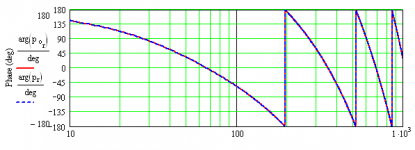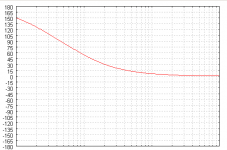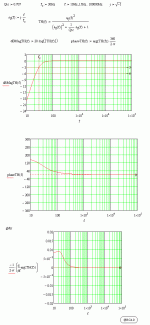[X-posted. There's no forum where this really belongs... No "theory" forum. I tried "software", but apparently no one reads that forum.]
I do not know how to calculate the theoretical phase response of a loudspeaker, and it's driving me nuts.
For example, I know that the amplitude response for a closed-box loudspeaker is given by the transfer function,
H(s) = s^2/(s^2 + s/Qtc +1)
Okay, I calculate Qtc and fc for the driver/box combination, and then for a range of frequencies x, I plug i*x/fc into the formula.
Amplitude = modulus( H(i*x/fc) )
Phase_response = degrees(phase( H(i*x/fc) ))
The amplitude chart comes out perfectly. But the phase is all wrong. It approaches zero as frequency grows. That's not surprising when one considers that H is also the transfer function for a second order high-pass filter. But phase charts for loudspeakers do not look like that. Below is a phase chart from MJK's Mathcad program, and the one that I get. Way different.
What's the trick? Martin?
[Added later. Oh, I think I see what's going on. The term "far field" comes into play.]
I do not know how to calculate the theoretical phase response of a loudspeaker, and it's driving me nuts.
For example, I know that the amplitude response for a closed-box loudspeaker is given by the transfer function,
H(s) = s^2/(s^2 + s/Qtc +1)
Okay, I calculate Qtc and fc for the driver/box combination, and then for a range of frequencies x, I plug i*x/fc into the formula.
Amplitude = modulus( H(i*x/fc) )
Phase_response = degrees(phase( H(i*x/fc) ))
The amplitude chart comes out perfectly. But the phase is all wrong. It approaches zero as frequency grows. That's not surprising when one considers that H is also the transfer function for a second order high-pass filter. But phase charts for loudspeakers do not look like that. Below is a phase chart from MJK's Mathcad program, and the one that I get. Way different.
What's the trick? Martin?
[Added later. Oh, I think I see what's going on. The term "far field" comes into play.]
Attachments
Nothing wrong with your procedure and your phase curve looks good for what you have done. You are just looking at your system as a perfect high-pass. Because of that you have phase shift due to the lower corner but no upper corner to give phase shift at that end.
The MJK phase shift appears to include a fair amount of propogation delay also (the continuous phase rotations). I'm guessing it either had distance delay or was the output of a TL port, including internal delay.
Try modeling a bandpass or some cascaded low pass/high pass sections. You'll see they have phase lead from the bottom corner and down and phase lag from the upper corner and up.
David S.
The MJK phase shift appears to include a fair amount of propogation delay also (the continuous phase rotations). I'm guessing it either had distance delay or was the output of a TL port, including internal delay.
Try modeling a bandpass or some cascaded low pass/high pass sections. You'll see they have phase lead from the bottom corner and down and phase lag from the upper corner and up.
David S.
Last edited:
If you look at equation 9 in the following paper :
http://diyaudioprojects.com/Technical/Papers/Direct-Radiator-Loudspeaker-System-Analysis.pdf
and then assume a simple source is being modeled, the response at a 1 m distance should match the curves from my MathCad worksheet. The transfer function you have shown is for a closed box or infinite baffle system so the corresponding MathCad worksheet should be used to calculate the SPL and phase for comparison. Most of the phase shift, as a function of frequency, is due to the 1 m distance from the source.
Hope that helps,
Martin
http://diyaudioprojects.com/Technical/Papers/Direct-Radiator-Loudspeaker-System-Analysis.pdf
and then assume a simple source is being modeled, the response at a 1 m distance should match the curves from my MathCad worksheet. The transfer function you have shown is for a closed box or infinite baffle system so the corresponding MathCad worksheet should be used to calculate the SPL and phase for comparison. Most of the phase shift, as a function of frequency, is due to the 1 m distance from the source.
Hope that helps,
Martin
..You are just looking at your system as a perfect high-pass...The MJK phase shift appears to include a fair amount of propogation delay also..
Agree, a simple Mathcad plot:
b🙂
Attachments
A nice rule of thumb with phase shift relative to rolloffs is that there will be an ultimate shift of 90 degrees per rolloff order. This will only occur well into the stop band. At the corner frequency you will see half of that, or 45 degrees per order.
So, for example, 3rd order would give 270 degrees ultimate phase shift, but only 135 at the corner.
High Qs give a quick rate of phase change, low Qs give slow change, which all ties in nicely to group delay effects.
David S.
So, for example, 3rd order would give 270 degrees ultimate phase shift, but only 135 at the corner.
High Qs give a quick rate of phase change, low Qs give slow change, which all ties in nicely to group delay effects.
David S.
Last edited:
If you look at equation 9 in the following paper :
http://diyaudioprojects.com/Technical/Papers/Direct-Radiator-Loudspeaker-System-Analysis.pdf
and then assume a simple source is being modeled, the response at a 1 m distance should match the curves from my MathCad worksheet. The transfer function you have shown is for a closed box or infinite baffle system so the corresponding MathCad worksheet should be used to calculate the SPL and phase for comparison. Most of the phase shift, as a function of frequency, is due to the 1 m distance from the source.
Hope that helps,
Martin
Thanks, Martin. I have squirreled away a copy of the Small paper. I did use the correct Mathcad worksheet of yours. After a couple of nights of "sleeping on it," it did occur to me that the answer lay in the "far field." I didn't know that it was one meter specifically.
Thanks for all the good work you have done, and for being so helpful.
- Status
- Not open for further replies.
- Home
- Loudspeakers
- Multi-Way
- Calculating phase - MJK?


